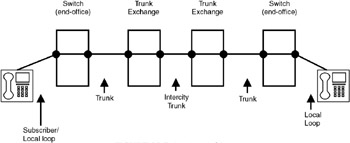11.3 SWITCHING CONCEPTS
|
| < Day Day Up > |
|
11.3 SWITCHING CONCEPTS
The PSTN operates on the circuit switching principle illustrated in Figure 11.5. When a subscriber calls another subscriber, a circuit is established that is a concatenation of various channels on the trunks between the switch connected to the calling subscriber and the switch connected to the called subscriber. Circuit switching operation involves the following steps:
-
Call establishment
-
Data transfer (conversation)
-
Call disconnection

Figure 11.5: Circuit switching.
PSTN operates on circuit switching. For two subscribers to converse, a circuit is established between the two subscribers, and after conversation, the circuit is disconnected. The circuit is a concatenation of various trunks between the switches.
To establish and disconnect the calls, information needs to be passed from the subscriber to the switch and also between the switches. This information is known as signaling information. In PSTN, the signaling is carried by the same physical channel that is used to transmit voice. The signaling between two switches is carried on the trunks. As shown in Figure 11.6, some trunks are assigned as signaling trunks and some as traffic (or voice) trunks. This is known as channel associated signaling (CAS).

Figure 11.6: Channel associated signaling.
To establish a call and subsequently disconnect the call, information needs to be exchanged between the subscriber terminal and the switch and also between the switches. For billing the subscriber and for network management, information is exchanged between the switches. This information is called signaling information and is carried on a signaling trunk.
Call processing software resides in the switch. The functions of the call processing software are:
-
To keep track of the subscriber terminals and to feed the dial tone when the subscriber goes off-hook (lifts the telephone).
-
To collect the digits dialed by the subscriber. Note that the subscriber may dial a few digits and then pause—the software should be capable of handling such cases as well.
-
Analyze the digits and switch the call to the right destination by seizing the trunk.
-
Feed various tones to the subscriber terminal (such as hunting, busy, call hold, etc.).
-
When the subscriber goes on-hook, free the trunk.
-
Keep track of the call records (known as CDRs or call details records) that contain call information such as date and time when the call is made, the called party number, whether the call is local/long distance, and duration of the call.
-
Based on the CDRs, do an offline analysis to generate billing information.
| Note | The call details record (CDR) is generated by the switch. The CDR contains the details of all the calls made. These details include calling subscriber number, called subscriber number, date and time when the call was initiated, duration of the call, and so on. Billing information is generated by processing the CDR. |
The switch also contains the diagnostic software to carry out tests on the subscriber loop and the subscriber terminals. This is done through special "line testing software" which feeds signals on the subscriber loop and measures various parameters to check whether the local loop is OK or faulty.
Though circuit switching has been used extensively for many years, its disadvantage is that the communication channels are not used efficiently. Particularly when voice is transmitted, nearly 40% of the time, the channel is idle because of the gaps in the speech signal. Another drawback is that the signaling information is carried using the same channels resulting in inefficient usage of the channel. In Chapter 26, we will discuss how signaling can be carried by a separate signaling network called Signaling System No. 7 which is being introduced on a large scale in PSTN.
The call processing software that resides on the switch carries out the following functions: collection of the digits dialed by the subscriber, to switch the call to the called subscriber by seizing the trunks, to feed the various tones to the subscribers, to free the trunks after the call is completed and to collect statistics related to the calls.
| Note | Circuit switching is not an efficient switching mechanism because a lot of time is wasted for establishing and disconnecting the circuit. An alternative switching mechanism is packet switching used in computer networks. |
|
| < Day Day Up > |
|
EAN: 2147483647
Pages: 313